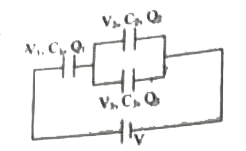The ratio of maximum particle velocity to wave velocity is [ where symbols have their usual meanings ]
kA
Aω
kω
ωk
The correct Answer is:A
To find the ratio of maximum particle velocity to wave velocity, we can follow these steps:
Step 1: Write the wave equation
The general wave equation is given by:
y(x,t)=Asin(ωt−kx)
where:
- A is the amplitude,
- ω is the angular frequency,
- k is the wave number.
Step 2: Differentiate the wave equation with respect to time
To find the particle velocity, we differentiate the displacement y with respect to time t:
vp=∂y∂t=A∂∂tsin(ωt−kx)
Using the chain rule, this gives:
vp=Aωcos(ωt−kx)
Step 3: Find the maximum particle velocity
The maximum value of cos(ωt−kx) is 1. Therefore, the maximum particle velocity vp,max is:
vp,max=Aω
Step 4: Determine the wave velocity
The wave velocity v can be expressed in terms of angular frequency ω and wave number k:
v=ωk
Step 5: Calculate the ratio of maximum particle velocity to wave velocity
Now, we can find the ratio of maximum particle velocity to wave velocity:
Ratio=vp,maxv=Aωωk=Ak
Conclusion
Thus, the ratio of maximum particle velocity to wave velocity is:
Ratio=Ak
The general wave equation is given by:
y(x,t)=Asin(ωt−kx)
where:
- A is the amplitude,
- ω is the angular frequency,
- k is the wave number.
To find the particle velocity, we differentiate the displacement y with respect to time t:
vp=∂y∂t=A∂∂tsin(ωt−kx)
Using the chain rule, this gives:
vp=Aωcos(ωt−kx)
The maximum value of cos(ωt−kx) is 1. Therefore, the maximum particle velocity vp,max is:
vp,max=Aω
The wave velocity v can be expressed in terms of angular frequency ω and wave number k:
v=ωk
Now, we can find the ratio of maximum particle velocity to wave velocity:
Ratio=vp,maxv=Aωωk=Ak
Thus, the ratio of maximum particle velocity to wave velocity is:
Ratio=Ak
Topper's Solved these Questions
- WAVESBOOK - AAKASH INSTITUTECHAPTER - WAVESEXERCISE - ASSIGNMENT ( SECTION-C ( Previous year Questions ))
52 Videos
- WAVESBOOK - AAKASH INSTITUTECHAPTER - WAVESEXERCISE - ASSIGNMENT ( SECTION-D ( Assertion - Reason Type Questions ))
12 Videos
- WAVESBOOK - AAKASH INSTITUTECHAPTER - WAVESEXERCISE - ASSIGNMENT ( SECTION-A ( Objective type Questions ))
49 Videos
- WAVE OPTICSBOOK - AAKASH INSTITUTECHAPTER - WAVE OPTICSEXERCISE - Assignment (Section-J (Aakash Challengers question))
1 Videos
- WORK, ENERGY AND POWERBOOK - AAKASH INSTITUTECHAPTER - WORK, ENERGY AND POWEREXERCISE - Assignment (SECTION - D)
15 Videos
Similar Questions
Knowledge Check
The relation between the particles velocity and wave velocity is -
Au=−vdydxBu=V(dydx)Cu = VDu=V+dydxSelect the incorrect relation. (Where symboles have their usual meanings):-
ACp=γRγ−1BCP−CV=RCΔU=PfVf−PiVi1−γDCv=Rγ−1Select the incorrect relation. (Where symboles have their usual meanings):-
ACP=γRγ−1BCP−CV=RCΔU=PfVf−PiVi1−γDCV=Rγ−1
Bohr magnetonis given by (symbols have their usual meanings)
View SolutionThe correct combination is (symbols have their usual meanings)

View SolutionChoose the correct arrangement, where the symbols have their usual meanings
View SolutionWhich of the following is correct ? (symbols have their ususal meanings)
View SolutionThe average intensity of electromagnetic wave is (where symbols have their usual meanings)
View Solution
